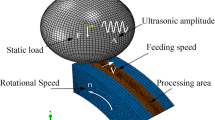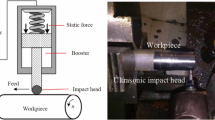Abstract
Ultrasonic surface rolling process (USRP) is a prospective approach that can improve fatigue property of a workpiece by improving compressive residual stress and microhardness in the modified surface layer, as well as improving surface roughness. However, because USRP is a complicated machining process, many studies on surface properties focus on experiment test and simulation method. Thus, analytical models of the modified surface layer should be established to facilitate the design and utility of the USRP. In the present work, analytical models of residual stress, plastic strain of modified surface layer, and surface roughness are proposed on the basis of Hertz contact theory and elastic–plastic mechanics, and the effects of processing parameters on the modified surface layer are predicted using the developed models. Results of the analytical models are consistent with experiment results. Therefore, the models can be used to guide the design of the modified surface layer and identify optimal processing parameters in USRP.



























Similar content being viewed by others
Data availability
The data supporting the findings of this study are available from the corresponding author on reasonable request.
References
Teimouri R, Amini S, Guagliano M (2019) Analytical modeling of ultrasonic surface burnishing process: evaluation of residual stress field distribution and strip deflection. Mat Sci Eng A-Struct 747:208–224. https://doi.org/10.1016/j.msea.2019.01.007
Magalhaes FC, Abrao AM, Denkena B, Breidenstein B, Morke T (2017) Analytical modeling of surface roughness, hardness and residual stress induced by deep rolling. J Mater Eng Perform 26:876–884. https://doi.org/10.1007/s11665-016-2486-5
Teimouri R, Amini S, Bami AB (2018) Evaluation of optimized surface properties and residual stress in ultrasonic assisted ball burnishing of AA6061-T6. Measurement 116:129–139. https://doi.org/10.1016/j.measurement.2017.11.001
Liu Y, Zhao X, Wang D (2014) Effective FE model to predict surface layer characteristics of ultrasonic surface rolling with experimental validation. Mater Sci Tech-Lond 30:627–636. https://doi.org/10.1179/1743284713Y.0000000396
Zhang GL, Yuan JP, Jiang CH (2013) Finite element simulation of residual stress of 18CrNiMo7-6 gear steel after shot peening. Materials for Mechanical Engineering 37(5):103–110
Wang T, Wang DP, Liu G, Gong BM, Song NX (2008) Investigations on the nanocrystallization of 40Cr using ultrasonic surface rolling processing. Appl Surf Sci 255:1824–1829. https://doi.org/10.1016/j.apsusc.2008.06.034
Liu ZH, Zhang TZ, Yang MJ, Zhang YX, Wang D (2020) Effect of ultrasonic rolling parameters on surface properties of 18CrNiMo7-6 gear steel. Surface technology 49(3):309-318. https://doi.org/10.16490/j.cnki.issn.1001-3660.2020.03.039
Liu ZH, Yang MJ, Deng J, Zhang M, Dai QL (2020) A predictive approach to investigating effects of ultrasonic-assisted burnishing process on surface performances of shaft targets. Int J Adv Manuf Technol 106:4203–4219. https://doi.org/10.1007/s00170-019-04902-9
Kattoura M, Telang A, Mannava SR, Qian D, Vasudevan VK (2018) Effect of ultrasonic nanocrystal surface modification on residual stress, microstructure and fatigue behavior of ATI 718Plus alloy. Mat Sci Eng A-Struct 711:364–377. https://doi.org/10.1016/j.msea.2017.11.043
Ye H, Sun X, Liu Y, Rao XX, Gu Q (2019) Effect of ultrasonic surface rolling process on mechanical properties and corrosion resistance of AZ31B Mg alloy. Surf Coat Tech 372:288–298. https://doi.org/10.1016/j.surfcoat.2019.05.035
Liu CS, Liu DX, Zhang XH, Liu D, Ma AM, Ao N, Xu XC (2019) Improving fatigue performance of Ti-6Al-4V alloy via ultrasonic surface rolling process. J Mater Sci Technol 35:1555–1562. https://doi.org/10.1016/j.jmst.2019.03.036
Zhang M, Liu ZH, Deng J, Yang MJ, Dai QL, Zhang TZ (2019) Optimum design of compressive residual stress field caused by ultrasonic surface rolling with a mathematical model. Appl Math Model 76:800–831. https://doi.org/10.1016/j.apm.2019.07.009
Teimouri R (2019) Optimization of residual stress field in ultrasonic assisted burnishing process. International Journal of Lightweight Materials and Manufacture 2:346–354. https://doi.org/10.1016/j.ijlmm.2019.04.009
Zhang M, Zhang YX, Zhou Y (2019) Theoretical and experimental analysis of compressive residual stress field on 6061 aluminum alloy after ultrasonic surface rolling process. P I Mech Eng C-J Mec 233:5363–5377. https://doi.org/10.1177/0954406219850218
Liu ZH, Dai QL, Deng J, Zhang YX, Ji V (2020) Analytical modeling and experimental verification of surface roughness in the ultrasonic-assisted ball burnishing of shaft targets. Int J Adv Manuf Technol 107:3593–3613. https://doi.org/10.1007/s00170-020-05261-6
Travieso-Rodriguez JA, Gomez-Gras G, Dessein G, Carrillo F, Alexis J, Jorba-Peiro J, Aubazac N (2015) Effects of a ball-burnishing process assisted by vibrations in G10380 steel specimens. Int J Adv Manuf Tech 81:1757–1765. https://doi.org/10.1007/s00170-015-7255-3
Wu B, Zhang LJ, Zhang JX, Murakami R, Pyoun Y (2015) An investigation of ultrasonic nanocrystal surface modification machining process by numerical simulation. Adv Eng Softw 83:59–69. https://doi.org/10.1016/j.advengsoft.2015.01.011
Teimouri R, Amini S (2018) Analytical modeling of ultrasonic burnishing process: evaluation of active forces. Measurement 131:654–663. https://doi.org/10.1016/j.measurement.2018.09.023
Johnson KL (1985) Contact mechanics. Cambridge University Press, Cambridge. https://doi.org/10.1017/CBO9781139171731
Li JK, Yao M, Wang D, Wang RZ (1991) Mechanical approach to the residual stress field induced by shot peening. Mat Sci Eng A-Struct 147:167–173. https://doi.org/10.1016/0921-5093(91)90843-C
Teimouri R, Amini S (2019) Analytical modeling of ultrasonic surface burnishing process: evaluation of through depth localized strain. Int J Mech Sci 151:118–132. https://doi.org/10.1016/j.ijmecsci.2018.11.008
Wang CL (2005) Plastic mechanics. China Architecture & Buliding Press, Beijing
Zhang M, Deng J, Liu ZH, Zhou Y (2019) Investigation into contributions of static and dynamic loads to compressive residual stress fields caused by ultrasonic surface rolling. Int J Mech Sci 163:105144. https://doi.org/10.1016/j.ijmecsci.2019.105144
Bouzid W, Tsoumarev O, Saï K (2004) An investigation of surface roughness of burnished AISI 1042 steel. Int J Adv Manuf Technol 24:120–125. https://doi.org/10.1007/s00170-003-1761-4
Li FL (2008) Study on the mechanism of rolling machining. South China university of technology, Dissertation
Huang Y (1986) Local stress and its application. China Machine Press, Beijing
Li FL, Xia W, Zhou ZY (2008) Analytical investigation and experimental verification of surface smoothing mechanism of roller burnishing. Journal of South China University of Technology 36:98–103
Acknowledgments
This work was supported by China Scholarship Council (CSC201908410361).
Funding
This work was supported by China Scholarship Council (CSC201908410361).
Author information
Authors and Affiliations
Contributions
Chenhui Zhang and Hao Zhao were responsible for the experiment; Dong Wang was responsible for the guidance of the experimental work; Zhihua Liu was responsible for completing the article; Vincent Ji was responsible for the guidance of the theoretical analysis. Zhihua Liu, Chenhui Zhang, Hao Zhao, Vincent Ji, and Dong Wang were involved in the discussion and significantly contributed to making the final draft of the article. All the authors read and approved the final manuscript.
Corresponding author
Ethics declarations
Ethics approval and consent to participate
Not applicable.
Consent for publication
Not applicable.
Conflict of interest
The authors declare that they have no conflicts of interest.
Code availability
The custom software code generated during the current study is not publicly available due to confidentiality policy.
Additional information
Publisher’s note
Springer Nature remains neutral with regard to jurisdictional claims in published maps and institutional affiliations.
Rights and permissions
About this article
Cite this article
Liu, Z., Zhang, C., Zhao, H. et al. Theoretical analysis and performance prediction on modified surface layer caused by ultrasonic surface rolling. Int J Adv Manuf Technol 113, 1307–1330 (2021). https://doi.org/10.1007/s00170-021-06642-1
Received:
Accepted:
Published:
Issue Date:
DOI: https://doi.org/10.1007/s00170-021-06642-1




